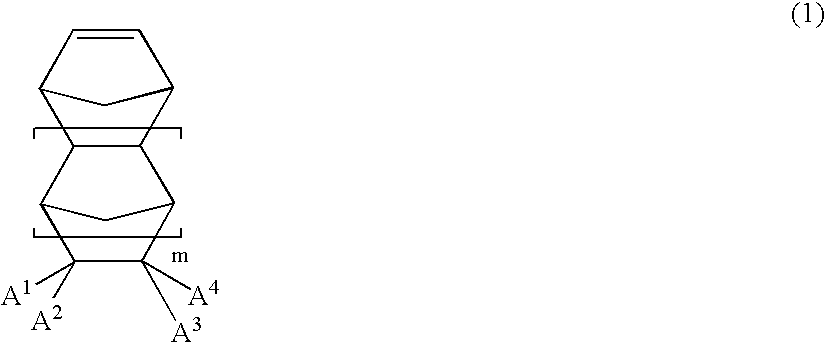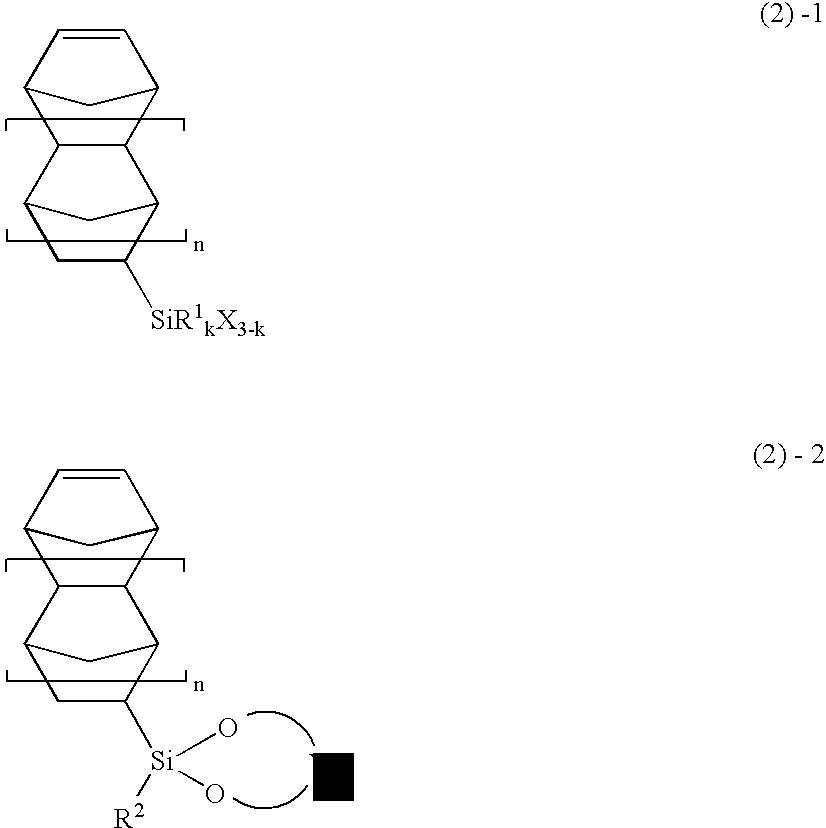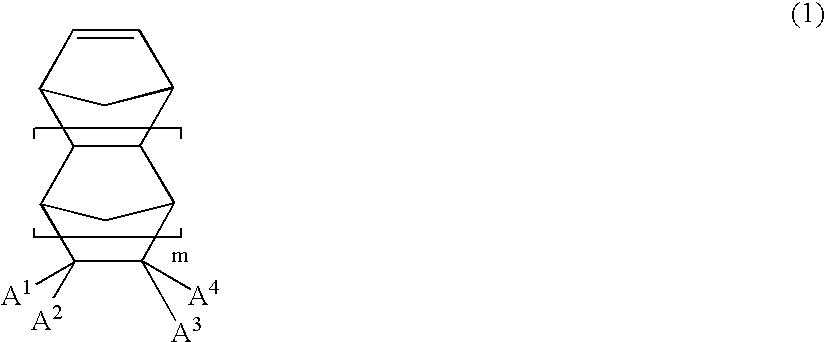Process for producing cycloolefin addition polymer
a technology of cycloolefin and polymer, which is applied in the field of process for producing cycloolefin addition polymer, can solve the problems of inability to say, poor dimensional stability of crosslinked products, and difficulty in controlling
- Summary
- Abstract
- Description
- Claims
- Application Information
AI Technical Summary
Problems solved by technology
Method used
Image
Examples
example 1
[0308] A 100 ml glass pressure bottle was charged with 30.7 g of dehydrated toluene having a water content of 6 ppm, 30.7 g of cyclohexane, 79 g (7.0 mmol) of 5-triethoxysilylbicyclo[2.2.1]hept-2-ene and 8.75 g (93 mmol) of bicyclo[2.2.1]hept-2-ene, and the charge opening was sealed with a crown rubber cap. Then, 30 ml of ethylene in the form of a gas was fed to the pressure bottle through the rubber cap.
[0309] The pressure bottle containing the solvent and the monomers was heated to 75° C., and palladium 2-ethylhexanoate (0.00133 mg atom in terms of Pd atom), 0.00133 mmol of tricylohexylphosphonium pentafluorophenylborate and 0.00667 mmol of triethylaluminum were added in this order to initiate polymerization.
[0310] After 15 minutes from the initiation of polymerization, a part of the polymer solution was sampled from the polymerization system. From the solid content in the polymer solution sample, a conversion of the monomers to the polymer was determined, and from 1H-NMR of 270...
example 2
[0314] Polymerization was carried out in the same manner as in Example 1, except that 0.00133 mmol of tricyclohexylphosphonium-2-ethylhexanoate and 0.00133 mmol of triphenylcarbenium tetrakis(pentafluorophenyl)borate were used instead of 0.00133 mmol of tricyclohexylphosphonium pentafluorophenylborate.
[0315] The conversion after 12 minutes from the initiation of polymerization was 18%, and the proportion of structural units derived from the 5-triethoxysilylbicyclo[2.2.1]hept-2-ene in the polymer was 12% by mol. The polymerization system did not become turbid until the polymerization of 3 hours was completed, and the conversion to the polymer was 97%.
[0316] The polymer B obtained as above had a number-average molecular weight (Mn) of 63,000, a weight-average molecular weight (Mw) of 167,000 and a glass transition temperature (Tg) of 365° C. The proportion of structural units derived from the 5-triethoxysilylbicyclo[2.2.1]hept-2-ene in the polymer B was 6.8% by mol, and the indicati...
example 3
[0317] Polymerization was carried out in the same manner as in Example 1, except that 90 mmol of bicyclo[2.2.1]hept-2-ene and 10 mmol of 5-trimethoxysilylbicyclo[2.2.1]hept-2-ene were used instead of 93 mmol of bicyclo[2.2.1]hept-2-ene and 7 mmol of 5-triethoxysilylbicyclo[2.2.1]hept-2-ene.
[0318] The conversion after 15 minutes from the initiation of polymerization was 18%, and the proportion of structural units derived from the 5-trimethoxysilylbicyclo[2.2.1]hept-2-ene in the polymer was 15% by mol. The polymerization system did not become turbid until the polymerization of 3 hours was completed, and the conversion to the polymer was 95%.
[0319] The polymer C obtained as above had a number-average molecular weight (Mn) of 72,000, a weight-average molecular weight (Mw) of 177,000 and a glass transition temperature (Tg) of 360° C. The proportion of structural units derived from the 5-trimethoxysilylbicyclo[2.2.1]hept-2-ene in the polymer C was 9.7% by mol, and the indication r of ra...
PUM
| Property | Measurement | Unit |
|---|---|---|
| temperature | aaaaa | aaaaa |
| temperature | aaaaa | aaaaa |
| temperature | aaaaa | aaaaa |
Abstract
Description
Claims
Application Information
 Login to View More
Login to View More - R&D
- Intellectual Property
- Life Sciences
- Materials
- Tech Scout
- Unparalleled Data Quality
- Higher Quality Content
- 60% Fewer Hallucinations
Browse by: Latest US Patents, China's latest patents, Technical Efficacy Thesaurus, Application Domain, Technology Topic, Popular Technical Reports.
© 2025 PatSnap. All rights reserved.Legal|Privacy policy|Modern Slavery Act Transparency Statement|Sitemap|About US| Contact US: help@patsnap.com



